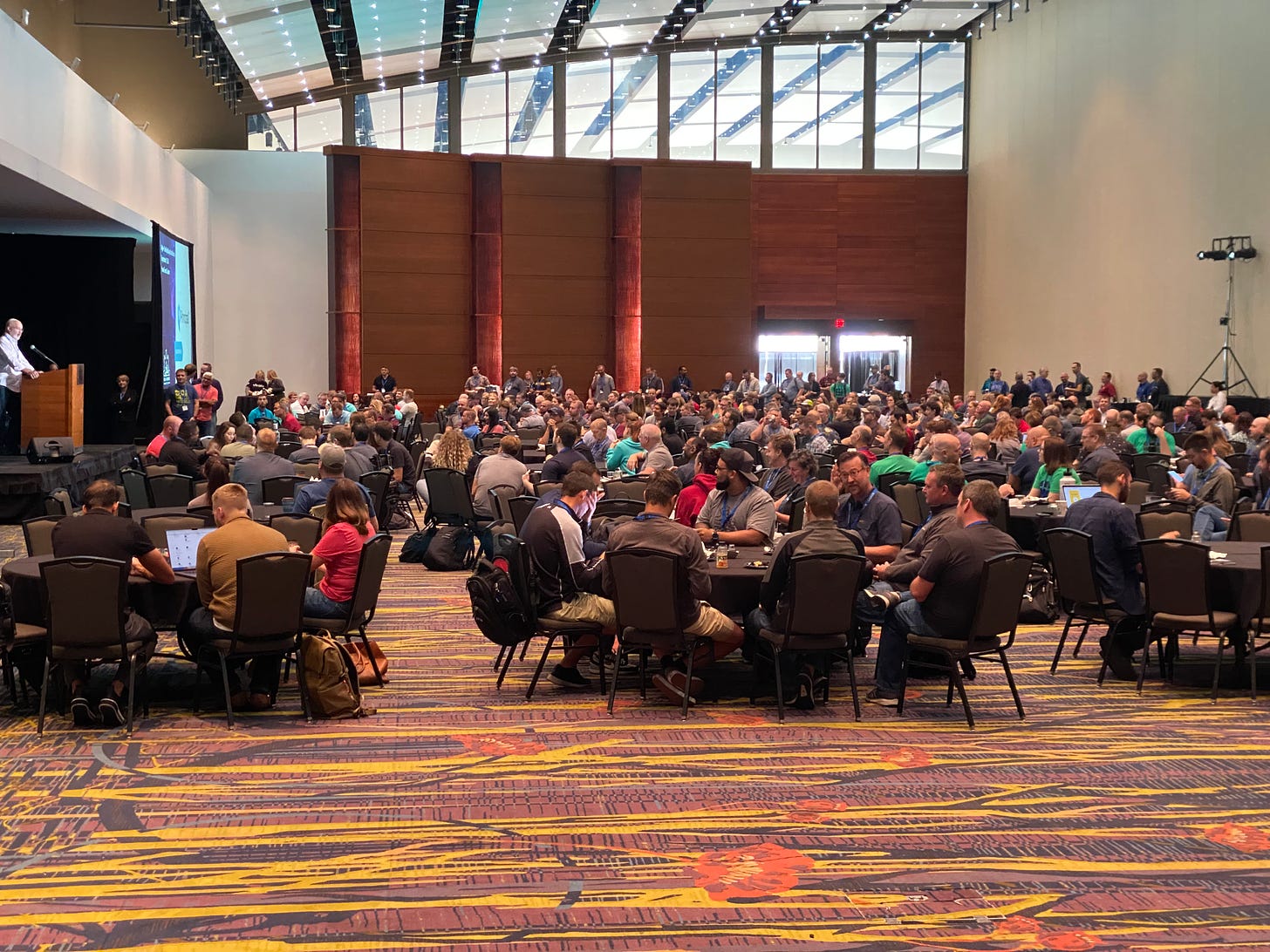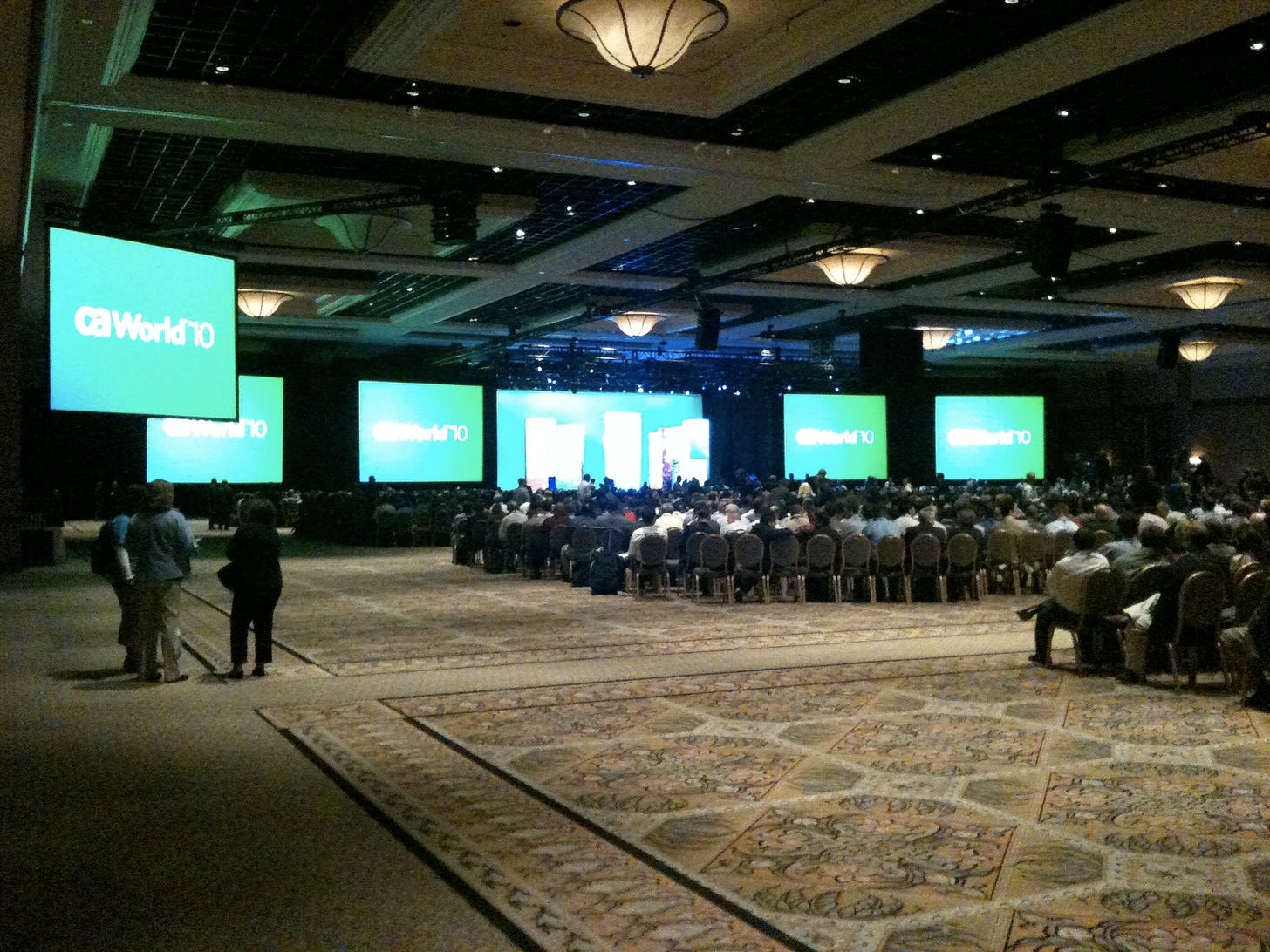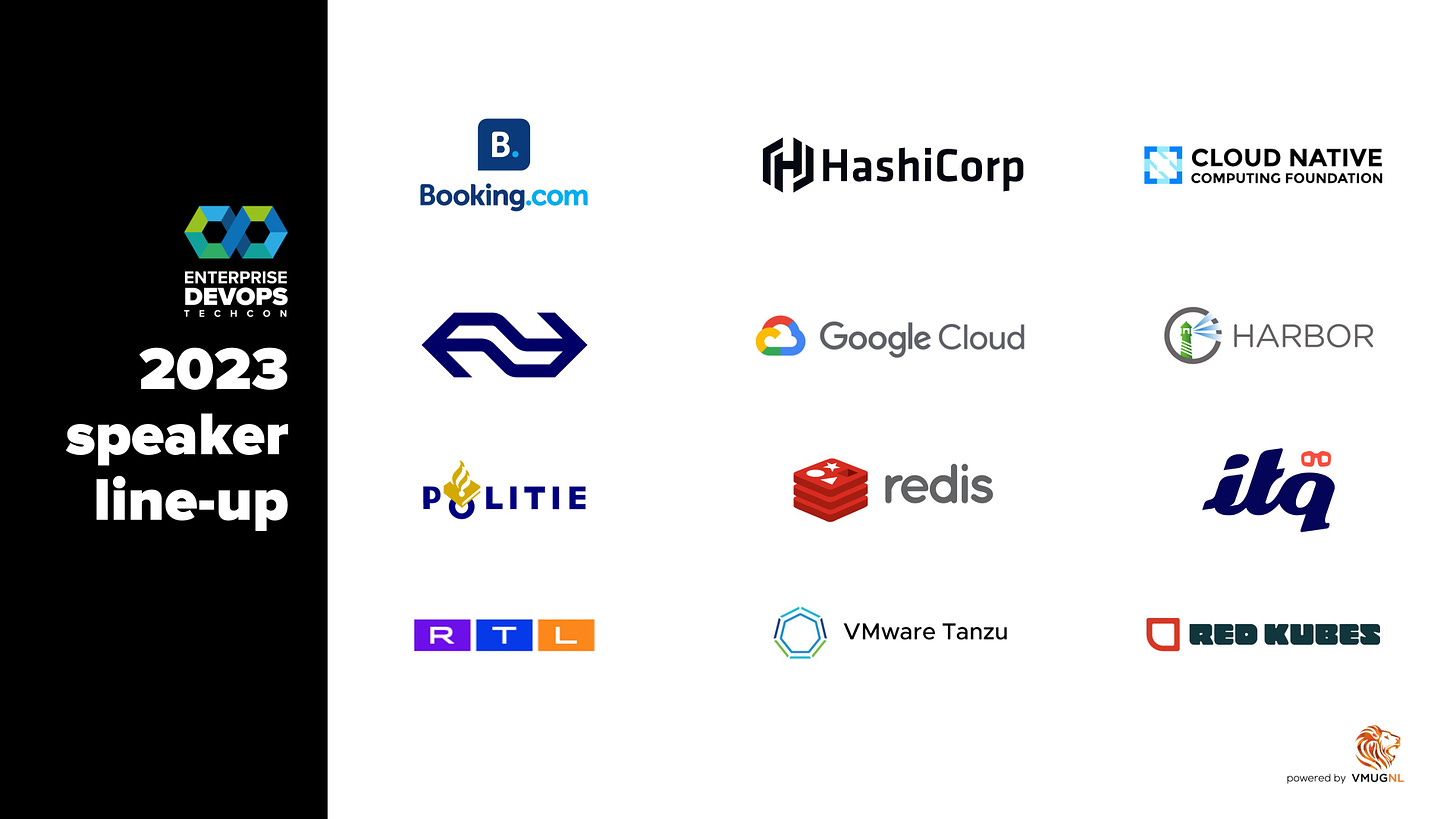Small, regional events are probably better than the mega-conference
I’m starting to think that small, regional events are much - like much - more important for enterprise software sales than the big, annual events. In enterprise sales (where you’re looking to work for a few years to build up multi-million dollar deals), you’re usually targeting a couple hundred mega-organizations (plus all the governments, large cities and states, and large universities). You know: banks/insurance/etc., manufactures, pharma, global retailers, etc.
Many of the people you need to win over (bottoms-up with developers and operations people, but also “middle-up” and even the executives at the top) just won’t travel to a mega-event. Plus, the mega-event tends to be so focused on speaking perfectly about the vendor’s identity that the actual content is both thin and overwhelming.
At a regional event, you can get more attendance from the accounts you want, and can focus time on what those people want. I feel like the leads you get at a small, regional event would be higher and more targeted, plus: you get the chance to have deeper conversations (relationship building, you know, selling) with individuals, you meet more people, can run the maze through the company social networks to find the influencers and deciders, hear more rumors about what’s going on inside your accounts to better position your pitch (often tailored to each individual and group), etc.
Also, small, regional probably a little cheaper than a mega-event. Not much though, because you’re doing a lot of little events. $50,000 in Chicago, then €50,000 in Amsterdam, then $50,000 in Austin…throw in travel expenses (business class for those 6+ hour flights if you’re a kind company with a bigger enough P/E) and steak dinners, and pretty soon we’re talking millions annually.
I mean, what you’d want to do is some reporting on the leads and accounts at the mega-events versus the regional events. Pure number of leads, even at target accounts, isn’t going to tell you much. You probably need to do an analysis six and then 12 months later and see how many deals were closed and deal size from activities at each event. You could throw in “follow-up meetings” as a second metric if you needed another slide in your deck. My hunch is that you’re going to help close more deals at a regional event. You might get associated with bigger individual deals at the mega-event, but that could be because you tend to invite higher-level executives to those events than your small ones.
I don’t know: I haven’t ever looked at this at a company I work for because (a) good fucking luck getting access to all of that unless you’re an executive who can get a team of people to figure it out dumping the CSVs from Salesfroce and then spending a few days Excel’ing it into something useful, and, (b) if I did get that info, it’d be proprietary info that I couldn’t share.
A regional event strategy does require a road-crew (hello!), but if you integrate the strategy into sales, you also get the bonus of working directly with the local sales reps and sales engineers. Ideally, you’d have your field facing people like, mostly sales engineers, give a couple of the presentations at the event. These are the people that the people in the audience will keep talking with as you work on closing the deals, not the fancy-talking evangelists (hello, me again!) that are flitting about city-to-city.
Outside of vendor-run conferences, this seems to be the case with other small events like, for sure, DevOpsDays and other regional events I’ve been to recently like stackconf (Berlin) and SREday (London). DevOpsDays Des Moines feels like it had at least 500 people in attendance. If you were selling to John Deere or the numerous insurance companies in Iowa (which, yes, you are if you’re in enterprise tech sales), you’re going to reach a shit-ton more people at an event like that than at your giant confab in Las Vegas, San Francisco, Orlando, etc.
The Big Event
The big event is, I guess, needed as more of an event about the company and their announcements. The Big Event is a press and analyst moment - you get all those people there, the “influencers,” and you get your story out and they generate a lot of content. Yay!
For me, The Big event should also be about customers and prospects that are close to finally paying. The Big Event is a prestige even for your customers - getting an invite and travel paid The Big Event is a good treat to give customers. You know, with whatever ethics and compliance applied to the letter, of course.
Just securing a customer a speaking slot is good. Most of the people at your customers (and prospects) don’t get the chance to speak at conferences very much, let alone ones that have good video production and will post the videos to YouTube.1 This is true for all types of staff. For executives at your customers, getting a keynote speaking slot is good for their careers.
And, then, there’s the content in the actual talks customers give. The regional, vendor conferences are mostly a set of the same talks from the vendor, not new ones each time. It’s like stand-up act on the road. It just looks like it’s fresh. Though, having a local end-user talk would be a good edition, as well as having the local sales team speak at the event, as mentioned above.
In contract, the mega-conference is your chance to get customers on-tape (which means, in YouTube) talking about using your technology…and, yeah, in addition to that, just general, helpful conference talks. It’s your chance (the vendor) to also get content in YouTube about your productions, your positioning, etc.
While I’m here, this is another thing that mega-conferences do weird. I want to tread lightly here because putting on a mega-conference is A LOT OF FUCKING TERRIBLE THANKLESS WORK. Just imagine spending ten hours deciding on t-shirts, packing cubes versus insulated water bottles, or figuring out if you have budget for hot dogs during breaks, or if it’s just going to be popcorn - throw in all the life and worldviews of a geographically dispersed and cultured team (“what if people are offended by corn?”) and you’ve got endless…endless meetings. Imagine picking a newborn’s name with 200 co-workers, but there’s lawyers involved and 100 executives, supporting by their staff whipping up PowerPoints proving that “Gerry” is the clear winner if you want to follow the Q3 guidance from McKinsey, and, really, is Statista really a site we want to get market data from(we have an IDC EULA, you know - oh, we’re a systems management company [sure, inside a hardware company] but for some reason we don’t subscribe to that part of IDC? File a ticket?)…meanwhile that other executive just took a screenshot of a James Governor tweet and, like, that’s all we had to do?…yeah…where was I?…right…vying for the baby’s name).
Anyhow.
The mega-conference is probably your number one channel during the year to build up your customer testimonials, references, and marketing. You should get as many of the talks as possible to be customers talking about using your product, or just validating your world view (“boy, we really needed to go cloud native to meet business demand,” said Really Big Insurance Company speaker). In fact, I’d say, that barring government policies, if you get a customer to speak, you should pay all of their travel expenses. Compare that to how much producing one of those fancy videos where people are walking around hallways and looking off camera as they say (hey, again, I know how much work it is) kind of vapid, too short testimonials that have been edited down to business jargon. The mindset of those videos is to be quick, short and sweet. Four minutes is considered long. That’s not really long enough to tell a meaty customer story.
A 45 minute conference talk by a customer can be converted into a logo on your “we’re sort of a big deal” slide, likely at least three other pieces of content, sliced into social vides, a PDF case study, then you can reference it in your own talks and presentations (this is, essentially, what I’ve made a career out of)…and then there’s the actual video itself!
Also, while you have customers there, you can do additional interviews and videos. The customers have already arranged their thoughts and gotten permission to speak publicly for the talk they gave. This means you can get them to talk more. And, you can put their content in other channels. I mean, you’re probably going to pay theCUBE to show up, maybe The New Stack, the CTO Advisor, moderately famous tech podcasts (call us!), right? Feed customers into those videos (if you’re paying for one of those show floor video outfits and you just have your execs talking with them, you’re losing out - get your customers on there!)
Where is the Mr. Beast of Enterprise Software Industry Analysis?
BTW: it’s beyond me why the big analyst firms don’t get into this “live from the conference room floor” business. I get the whole pay for play, blah, blah, but: really, no one gives a fuck, that’s some kind of internal neurosis those firms have. At the very least, 451 Group/S&P Global Whatever should be in that game. I know it’s easy to say after doing it for 20 years with the, uh, DIY quality that allow myself, but doing it all is not a big deal. You don’t need to be some Monday Night football quality-level like theCUBE. What’s more important is the content quality and distribution. If you got people like RedMonk or the helpful bullshit-detector sass of a Gartner analyst interviewing vendor execs and customers at The Big Event, it’d be great content and analysis - but the full video behind the analyst paywall, even. I think these firms don’t do it because (a) as mentioned it’d just out of their skills and comfort level, and, (b) classic innovator’s dilemma self-harm (they can’t re-prioritize budget and analyst time to go for what seems like a lower-quality, lower value product but ends up being just fine once you figure out the business model and invest in it for 24+ months).
O’Reilly should get into this too. Maybe Pluralsight, or whatever. I think those tech publishing companies are trying to figure out doing a paywalled YouTube, which I think could work (think scaling Ben Thompson, sort of). You put 1/4 to 1/2 of each video on YouTube and ALL THE SOCIALs, and then you have the full video behind your paywall. A huge chunk of revenue from those companies (and analyst shops!) comes from ARR: company-wide subscriptions to their services that are on a two to three year time bomb of lost revenue. Just like with software, if you’re an analyst shop or O’Reilly, over the course of that 12+ month subscription, you have to drive consumption. You want people at the companies viewing your content. Otherwise, at the end of that contract term your customers will be like “year, but no one really used this service, so how about we cut how much we pay you by 90%?” In that model, the content provider needs to stuff as much content as possible into their platform: just, like, anything! So, you’d get the big vendors to, at the minimum, pay travel and expenses to go their conferences and just interview the shit out of all the speakers. Win-win!
Also, as Richard Seroter points out, the mega-event is an important event for getting your own employees together.
Speaking of…
If you’re into cloud native apps, kubernetes, and all that, and you can make it to Utrecht on October 3rd, you should come to Enterprise DevOps TechCon. They’ve put together a really good agenda, including talks from The Dutch Police about how they’ve been running their apps, an overview of the same at RTL/Videoland, and The Netherlands Railways (NS). Plus, all sorts of other technical talks. Oh, and an opening talk from me. I’m looking forward to it - you don’t get to see that density of practitioner talks too often. And, it’s totally free to attend! Register and come check it out.
Wastebook
My new theory is that there are too many managers and middle-people in the software process. I’m not trying to be an anarchist here, or anything. The developers should talk directly with the security and governance people, not through meetings and the tunnels. The developer team should talk directly with “the business” about what they need, and directly with customers/users. In the same way, the ops people should talk directly with the app developers. Draw up the old value stream and see where you’re waiting for a review meeting, a management decision, an authorization of some sort. With all the cloud native automation/shift left stuff, why is that needed? Figure it out and if the development team can just decide themselves, do that.
#LifeHack if you’re going to write a thing that you’re sick of covering or paying attention to some topic, then you’re still paying attention to that topic. No need to mention that you’re sick of it and are going to stop. Just stop. 🤯
Relative to your interests
What is an Authority to Operate (ATO)? - Governance in the military.
Salesforce CEO takes another bold stand on remote work - Another chapter in the no one knows WTF on WFH deal saga: “For my people that’s my message. They need to mix in person and remote together. Our engineers are extremely productive at home. We have lots of people who are extremely productive at home. But there also has to be sales people being productive in the office selling to customers and we need to make it all work.”
DevOps Patterns for Private Equity: Technology organization strategies for high performing software investments - Wait, wut? As someone in the Software Defined Slack quipped, this should really be sponsored by Thomo Bravo, Silverlake, Vista, etc.
VMware Introduces Frameworks And Services At Explore Conference To Enable Enterprise Adoption Of Generative AI - Quick analysis of VMware’s AI strategy.
Everyone is Busy: Who Has Time to Transform? - Mark tries to crack the “how to engineer a corporate structure, plan, and incentive plan to actually change” problem of digital transformation. I think the answer is: make small goals that you do on a short (quarterly) basis instead giant, waterfall annual strategy plans. // “My role at USCIS involved a huge transformation project. Our initial mistake was to think of it as a monolithic effort; we were going to make all the agency’s paper processes into digital processes. It would have been better to clarify the business outcomes, which were achievable. We knew we wanted to reduce the amount of paper that moved between our offices; that let us prioritize addressing the parts of the business that moved the most paper. We knew we wanted to be better at detecting fraudulent applications; that clarity let us focus on the types of immigration benefits most susceptible to fraud. And so on for our other goals. With this clarity, we tied the transformation to everyday activities rather than going off and building technical infrastructure as a sideline project.”
US Banks Must Get Ready For Open Banking Now - Banks and regulations: the source of enterprise tech spend! It’ll probably make banking better for individuals too. If that happens, along with USB-C finally getting to the iPhone, this will be an era of government regulations helping us out a lot in tech-land. Sure, the tech people will be all like “do we want the government decided tech innovation?” And I think I’d be like “yes, someone has to, cause no one else seems to be doing things that purely favor the customer/consumer, regardless of ‘business impact.’” I mean, whether a company is profitable or not is not my problem as a customer. My job is to get as much value out of the company as possible, not help them be profitable. DIGITAL TRANSFORMATION FOR THE PEOPLE.
UK.gov efficiency hurt as legacy tech upgrades stall - Security is always the FUD-stick: “Dame Meg Hillier MP, PAC chair, said: ‘Whitehall’s digital services, far from transforming at the pace required, are capable of only piecemeal and incremental change. Departments’ future-proofing abilities are hobbled by staff shortages, and a lack of support, accountability and focus from the top. In particular, a lack of cyber-security experts should send a chill down the government’s spine.'”
How Can CIOs Communicate the Business Value of IT? - Talk with biz-normals about how technology can make the organization better, not on the activities that’s required to do so: "IT demonstrates value when we enable business outcomes, not when we report effort expended, resources consumed or work done…. Highlight the impact technology can have on business outcomes, so the value in the investment is recognized and IT gets the funding it needs.”
Upcoming
Talks I’ll be giving, places I’ll be, things I’ll be doing, etc.
Sep 18th to 19th SHIFT in Zadar, speaking. Oct 3rd Enterprise DevOps Techcon, Utrecht, speaking. Oct 5th to 6th Monktoberfest, Portland, ME. Oct 9th Spring Tour Amsterdam Nov 6th to 9thVMware Explore in Barcelona, speaking (twice!).
Logoff
Thanks for all the feedback on yesterday’s episode. I learned long ago that you can never tell what people end up liking, so it’s good to hear from them when they do. And, I mean, it’s always good to hear positive feedback even it’s just a little heart click thing.
I’m sure all of you are just right up in the thrill of talking about enterprise tech mini-events in, like, Eindhoven and Kansas City, right?
You have to post all of your videos to YouTube. Whatever advantages you think you’re getting hosting it on your own is, like, not. Switch your KPIs over to YouTube engagement (nevermind views, you want longer watch times on each video). I mean: really, we all know this. (This is for the vendors, keep reading the see who should be putting the full videos behind a paywall.)




